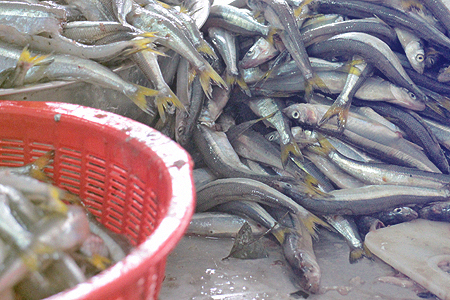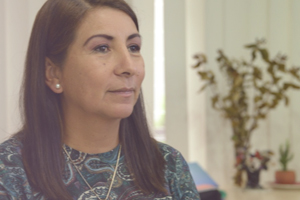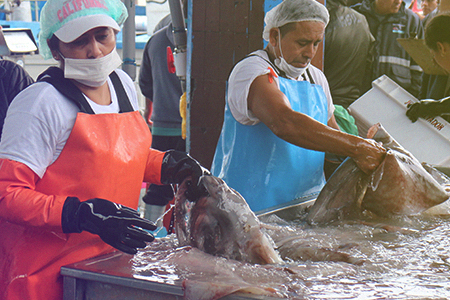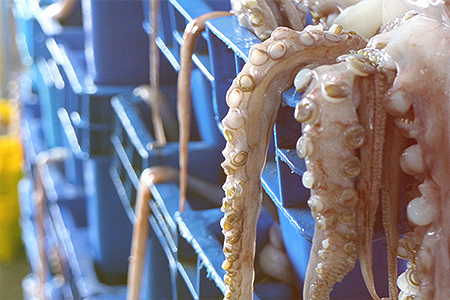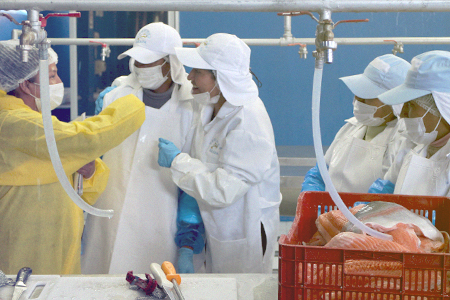Fishing for innovations in Peru
How innovation and investment are transforming Peru’s fisheries and aquaculture sector, boosting productivity and incomes and ensuring a better, more sustainable use of resources.
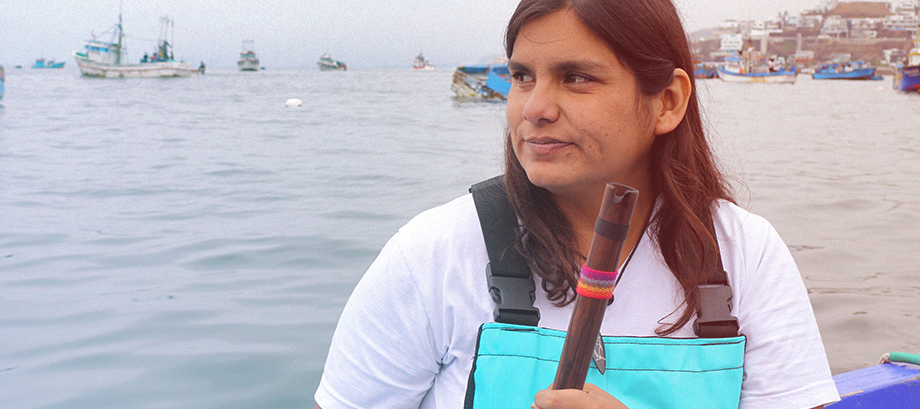
Karin Abensur plays the qena, a traditional Andean flute.
Pucusana, Peru, June 2019.
When Peruvian fisher Karin Abensur caught nearly 800kg of fish early one morning five years ago, she calculated roughly how much she would earn.
“I thought, worst case scenario, they would give me 6 soles per kg”, she says.
But when she returned to the port of Pucusana in central Peru, after four hours on the high seas, she was disappointed to be offered just 1 sol per kg – roughly USD 0.30.
"They said ‘take it, because no one will give you more.’ I had hoped for a four-digit number, but I left with less than 700 soles," she says.
The market value of captured species like spiny dogfish and angelshark, abundant along the Peruvian coast, is generally low.
Karin realized that to become more competitive, she would have to innovate and offer new products and services. Peruvian restaurants and consumers are increasingly interested in locally-sourced, sustainable fish. With that in mind, she started her company ‘Karin Ecofish’ in 2017. The company trains female workers in the port on innovative cutting techniques.
In addition to cleaning and gutting the fish, these women are now skilled in making intricate Japanese-style cuts, which fetch a higher price in the market.
"I am taking a chance on Asian-style cuts with bonito,” she says, referring to a locally-caught fish similar to tuna or mackerel but less expensive.
“There are people who want to go out for sushi but don't have enough money, so I sell them a cut of fish that is ready to use," she says.
She wants more people to eat fish, so she’s expanding her product range, training cutters to make fish nuggets and fish fingers for children and grill-friendly cuts for family gatherings.
On the left, Pejerrey (silverslide) is one of Peru's top seasonal fish species in June. On the right, Karin Abensur pulling her fishing nets onto her small boat.
Pucusana, Peru, June 2019.
Greater involvement and ownership
Karin's is one of about 800 projects supported by the Government of Peru's Fisheries and Aquaculture Innovation Program (PNIPA). The programme has been under way since 2017 through the Ministry of Production, with funding from the World Bank and technical investment support from FAO.
PNIPA first took shape in 2015, when the Government of Peru requested assistance to help address technical gaps in its fisheries and aquaculture sector and halt the depletion of the environment, hastened by a changing climate.
PNIPA promotes innovative initiatives with the dual goal of improving the livelihoods of workers in the sector while ensuring a more responsible and sustainable use of natural resources.
From right to left, Rosmary Cornejo, PNIPA’s Executive Director, Dennis Escudero, FAO Investment Expert, and Marianne Fay, World Bank Director for Bolivia, Chile, Ecuador and Peru.
According to Marianne Fay, World Bank Director for Bolivia, Chile, Ecuador and Peru, this ambitious programme “wants to change the way in which we combine job creation, improved nutrition, economic growth and natural resource management.”
“And innovation is fundamental to this, especially if we want economic growth to be sustainable, dynamic and equitable,” she adds.
Dennis Escudero, an FAO investment expert, helped design the programme, drawing on his experiences with innovations in Bolivia. He has also advised the programme from the beginning, noting the importance of PNIPA’s participatory and bottom-up approach.
The communities themselves are coming up with innovative solutions, he says, and the programme is seeing the “participation of all kinds of groups, funding initiatives that arise from real needs in different supply chains.”
The programme relies on co-financing. Once a project has been selected through a competitive process, the recipients make an initial financial contribution, with PNIPA funds covering the rest. This approach leads to greater involvement and cements ownership among the recipients.
"The innovations are a result of these men and women forming alliances and working together; we merely accompany them through the process," says Rosmary Cornejo, PNIPA’s executive director.
Innovation the name of the game
Since the programme began, innovations have popped up throughout the country, from the coastal regions to the highlands and jungle areas. Some involve the research and development of new technologies; others focus on boosting productivity and efficiency along supply chains.
One initiative aims to improve the quality of South America’s largest freshwater fish – pirarucu, also known as the king of the Amazon river – and to promote its entry into the international gourmet market. The fish is extremely nutritious and its skin can be used to make textiles.
Peru is also one of the biggest exporters of raw pota or jumbo squid. Another project seeks to make the fishing of pota more efficient and cost effective and to process it for greater market value, like extracting the ink.
Pota or jumbo squid is one of Peru's biggest fishery exports.
Pucusana, Peru, June 2019.
Innovation against climate change
Sustainability is a key pillar of the programme. “Sea conditions were already worrying in the early 2000s,” says Manuel Milla, a member of the PNIPA Board and President of the Marcona fishing community.
El Niño-related weather conditions have drastically reduced the number of fishing days for communities in Marcona on Peru’s north coast. “Some communities have switched from fishing to collecting and marketing marine macroalgae,” says Milla.
This includes sargassum, a brown seaweed that used to rot along the sea shores. Sargassum can be used to make products ranging from organic fertilizers, cosmetics and pharmaceuticals to nutritional supplements. It can also be used to make disposable plates, reducing the use of plastics. Selling the seaweed has given these communities a reliable, safe and sustainable way to earn a living. They no longer have to depend solely on the day’s catch.
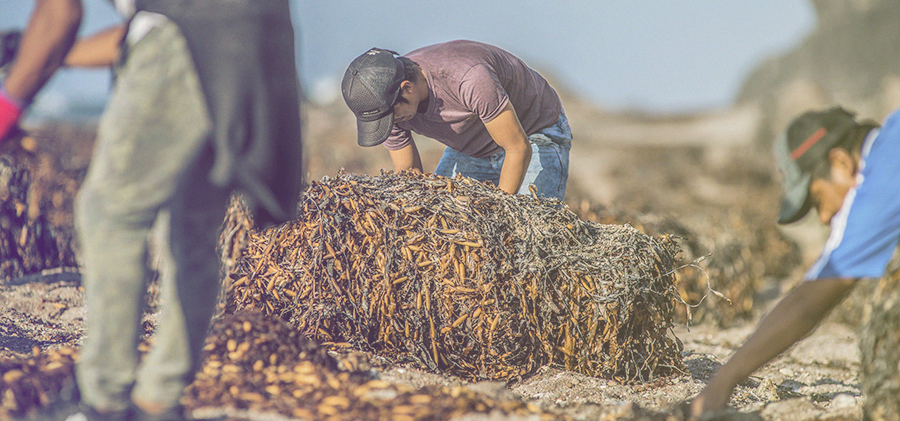
The communities in Marcona have transitioned from extractive fishing to collecting sargassum along the sea shores.
Marcona, Peru, November 2018.
Driving sustainable aquaculture
Adding value to a product can increase its commercial appeal. On Lake Arapa, in the Puno region, a mostly female aquaculture group produces a striking red-coloured trout at almost 4,000 meters above sea level. Thanks to PNIPA’s support, the group has learned to extract axtasantin, a natural dye, from the munida fish, a common Peruvian bycatch. Incorporating axtasantin into balanced trout feed not only changes the colour and flavour of the Arapa trout but also increases its protein levels.
One of Lima’s top restaurants now serves the fish. Reyna Callata, commercial director of Truchas Arapa, explains that they were "sure this unique trout, healthy and high in protein, would have a good demand, with fairer prices leading to new jobs for people in the area.”
Female-led Arapa trout initiative trains local communities in innovative fish processing techniques. On the right, Marisol Churacutipa and Reyna Callata, Head of Production, and General Manager of Truchas Arapa respectively.
Lake Arapa, Puno, Peru, May 2019.
On the right track
PNIPA is building on the fishing communities’ ancestral knowledge. It is helping them manage and safeguard their fishery resources more efficiently and tap into new markets.
The programme is expected to support almost 2,000 initiatives during the first phase, which will end in 2022. Rosmary Cornejo, PNIPA’s Executive Director, anticipates a second phase to advance the sector’s development: “This is a process of collective learning, with an entire sector instructing itself on how to better manage projects. If we want to create opportunities for more sustainable, fair and innovative fishing and aquaculture in Peru, we are on the right track.”

